Nearly 17 percent of the population has already experienced damage due to damp in their apartment or house. Nowadays buildings are insulated much better, in fact insulation has become so good that almost no air exchange is possible anymore. Insufficient or incorrect ventilation and temperatures promote mould growth.
Optimising indoor climate:
Measures to prevent humidity and mould
Contents
1. Different types of mould
2. Humidity as a foundation
3. Preventing cold and condensation
4. Nutrient supply for mould
5. Optimising indoor climate with ventilation and heating
6. Using adequate ventilation technology
7. Reasonable measures for insulation and materials
8. Final tips

Mould is one of the invisible damages in the house or apartment. Invisible meaning that many spores can spread throughout the building undetected, causing allergic reactions and even disease. The spores count amongst the most common allergens indoors and pose a great threat to health if not removed in time. Apart from respiratory disease, lack of concentration and irritation of the skin can occur as well.
Nearly 17 percent of the population has already experienced damage due to damp in their apartment or house. One one hand today’s buildings are insulated much better, barely allowing any air exchange, on the other hand the indoor climate provides more than enough breeding ground for spores when exposed to insufficient or incorrect ventilation and temperatures.
There are countless measures for taking action against mould and tips for a more conscious behaviour during everyday life.
Source: co2online.de

Different types of mould
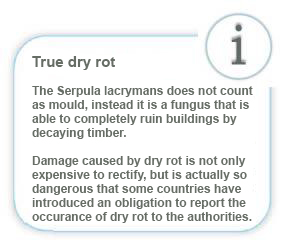
Most mould fungi are part of the environment and appear naturally in materials such as leaves, compost or stacks of firewood. Furthermore food makers use mould fungi to refine types of cheese and wine or to promote effects of metabolic products.
The damaging impact of mould fungi depends on their concentration which can cause many disease patterns. Usually concentration is divided into three categories, starting from surface damage below 20 cm2 to small areas of 0.5 m2 and large-scale spread above 0.52.
The following mould fungi are most common in households:
Alternaria
Aspergillus
Cladosporium
Penicillium
Most are familiar with Aspergillus niger, black mould, which mainly attacks paper, boxes, leather and synthetic materials, whereas Penicillium colonies grown on wallpapers, in mattresses or even in fruit. Some of them can contain mould toxins (Mycotoxins) that cause food poisoning for instance, if mouldy food has been consumed. Spreading through the air they cause other diseases and harm. They cannot be killed by cooking and frying.
Yellow mould
Green mould
Black mould
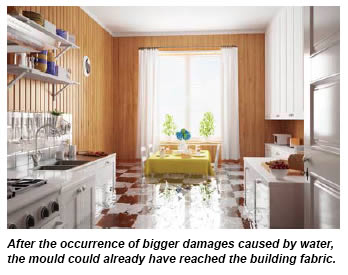
Often Aspergillus flavus with a yellow to ochre brown appearance. Habitats are humid corners, but also textiles, nuts and wheat.
Can cause organ damage and affect the respiratory tract.
Mostly attacts fruit and vegetables and other foodstuffs. Greenish colour with tendencies to brown and grey.
Habitats are humid wallpapers or corners in a room.
No acute health threat.
Alpergillus niger is recognised by its black spots and persists on wallpapers and walls.
Stachybotrys chartarum also occurs with a black colouration.
In the worst case causes disturbances of memory or terminal diseases.
|
Yellow mould |
Green mould |
Black mould |
|
|
|
Humidity as a foundation
Humidity is one of the main causes of the formation of mould fungi. The ideal humidity levels for living, office and bedrooms ranges between 40 to 60 percent, in kitchens and bathrooms this level can increase to 50 to 70 percent. If those values are below or above the recommended ones, both health and the building can be harmed.
A cause for an increase in humidty are exhalations of the residents on one hand, on the other hand activities such as taking a shower or bath, cooking and sleeping create increased humidity. Breathing and sweating alone result in one litre humidity a day per person. Humidity is always changing, which is why residents are urged to monitor it regularly. Ideally, indoor humidity in winter is lower than in summer, because warm air generally absorbs more humidity than cold air. Hygrometers help identify relative humidity and take measures if required.
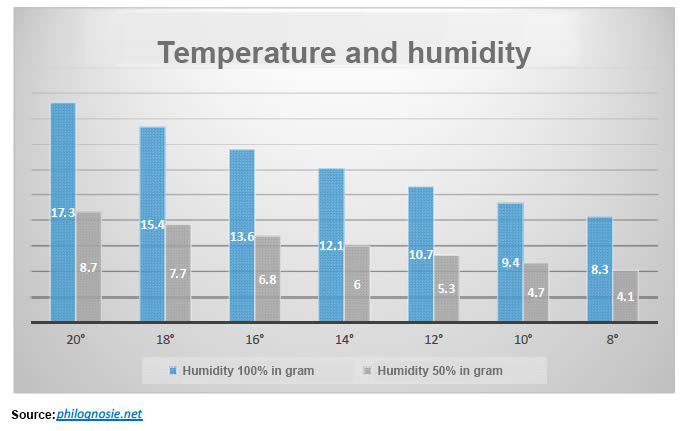
Preventing cold and condensation
Cold and warmth are decisive factors for the formation of mould, the more the apartment cools down, the faster spores can spread. The reason for that is that humidity can accumulated better inside cold rooms, as cold air absorbs less humidity, therefore forcing walls and furniture absorb it instead. If there is too much humidity and cold temperature, water for example starts to condense on windows or even on walls. If you start to ventilate in time, you allow an exchange of warm and cold air so that the water can condense outside the building. This process is called dew point and it continues until the saturation of 100 percent is decreased again.
Continuous heating prevents mould
Experts always point out that consistent heating with regular ventilation during the colder seasons can prevent the formation of mould spores. It is best to constantly keep the temperature between 19 and 21 degrees, and to reach at least 16 degrees in rooms that are used less often.
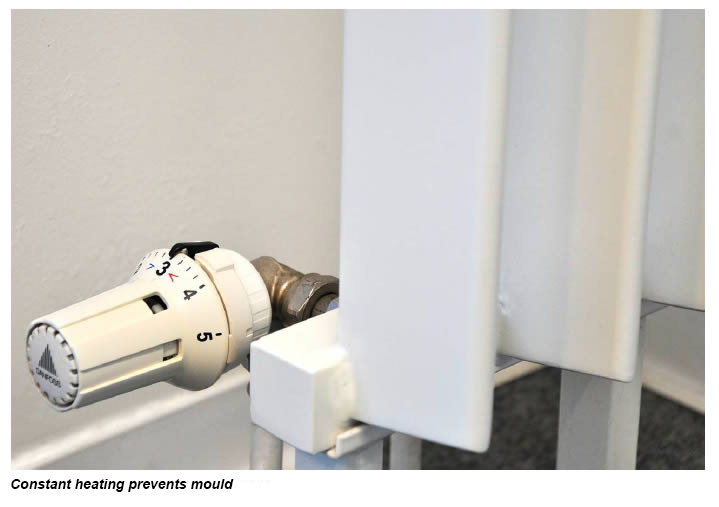
Nutrient supply for mould
Mould can make use of a wide scope of material, ranging from types of wood to paper, cardboard, wallpaper, but also glue, synthetic material, paint, rubber, lacquers, leather or carpet. In bathrooms for example they use organic food sources in soaps or shampoos and concentrate in joints made of silicone. The spores are extremely resistant and can withstand frost, heat or drought, once there is sufficient nutrients again, they also start to reproduce again. Mould takes the required carbon and nitrogen compounds from wallpapers and glue, on walls without wallpaper even wet handprints suffice.
That is why building material is recommended that has a capacity for sorption and are open for diffusion, to absorb and emit humidity.
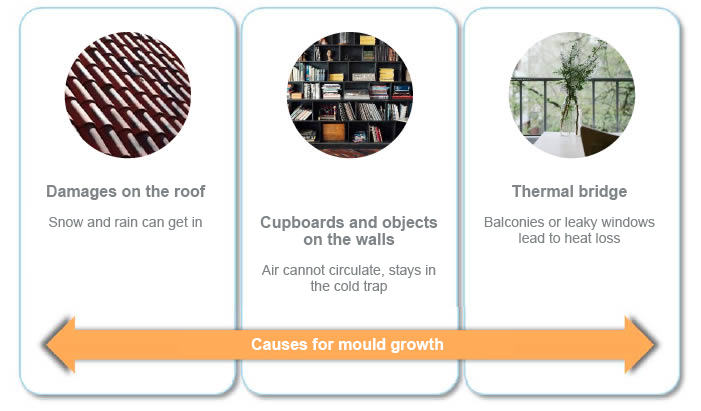
Optimising indoor climate with ventilation and heating
The most efficient method to prevent mould formation is a regular exchange of humid air inside the building. The indoor climated is crucial for a home without mould infestation, as little as 10 degrees Celsius are enough to cause fungi to grown, 30 degrees are their ideal temperature. Depending on the season of the year and humidity different times for ventilation are recommended if no further technical devices are available or installable. In winter four to six minutes are enough, whereas at least 25 to 30 minutes should be spent airing in summer.
Comprehensive ventilation means that windows and, if possible, a door or other window on the opposite side of the room should be opened completely. Especially in winter this results in the desired air exchange within just a short time.
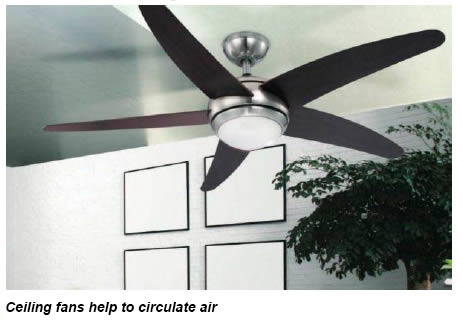
The ceiling fan offers good support, it has a reverse function for wintert o transport warm air from the ceiling back into the room. This prevents walls from cooling down, at the same time the movement allows humidity to get outside.
Most people have comfort level between 20 and 23 degrees in winter, in summer it is 26 degrees. Rooms should be kept at these temperatures consistently to create a pleasant feeling in combination with a humidity of 40 to 60 percent. The majority of people is happy with 20 degrees. At night, however, roller blinds should be closed to prevent loss of heat through the window glass. Thermostatic valves are able to automatically adjust the desired temperature and keep the home heated at all times. One degree Celsius less it is already possible to save 10 percent heating costs. Fan heaters are another possiblity, as they can be adjusted individually to requirements of the owners and on-site conditions. The Vornado fan heater iControl for example has an integrated thermostat.
Using adequate ventilation technology
In order to reach the required humidity and generate a pleasant indoor climate there are other alternatives to heating and ventilation. Humidifiers can be used if the values in winter are too low in the premises, and the climated gets to a disagreeably dry level. Humidifiers allow you to adjust settings for humidity and ensure constant circulation of air in the entire room. If you are not only looking to create more humidity, but also want to rid the room from pollutants, air purifiers are a great way to achieve this. Those devices usually come with activated carbon filters, photocatalytic or electrostatic filters, which filter out different pollutants such as house dust, mites, bacteria or gas.
|
Substance |
Approximate value II mg/m3 |
|
Carbon monoxide |
60 |
|
Nitrogen dioxide |
0.35 |
|
Styrol |
0.3 |
|
Mercury as vapour |
0.00035 |
|
Toluol |
3 |
|
Naphthalene |
0.02 |
Ceiling fans help residents to circulate air that is already present in the premises to create a balanced humidity level in all necessary rooms. Particularly in bathrooms special bathroom fans should be installed by the owners, without a window humidity has almost no way to leave, except from escaping to other rooms. Intelligent fans possess a humidity sensor, hygrostat and timer, so that the bathroom can be ventilated whenever it is necessary.
Reasonable measures for insulation and materials
Nowadays most houses have extensive insulation, leaving almost no possiblity for a natural air exchange. It is still possible to better control humidity on the inside. Loam rendering can absorb humidity better due to its natural sorption capacity, whereas lime plaster or coatings with lime offer little breeding ground for fungi.
Special attention should be paid to synthetic materials, tiles, cement, metal or glass, these materials have a hard time absorbing humidity, or even prevent absorbing due to their coating. An interior insulation with materials open for diffusion, such as dampening material made of wood fibre, cellulose or mineral wool, can cause the insulation to breathe. Mineral wool is characterised by its ability to dry out unhindered, this insulator is mostly resistant to mould. That way humidity can be emitted again when appropriated insulation is present.
Other substances in the interior insulation are calcium silicate panels that absorb a lot of humidity thanks to their high pH value, their permeability lets them dry quickly.
Final tips
Leave the bathroom door closed after taking a shower or bath
Ventilate even when it is raining outside
Don’t dry laundry inside the house, if you have no other choice however, ventilate multiple times a day
Don’t set up cupboards on external walls or leave at least five centimetres space in between
Heat constantly
Remove thermal bridges
Image sources:
Banner: pixabay.com © tookapic (CC0 1.0)
Image 1: © Karin & Uwe Annas - Fotolia.com
Image 2: © Robert Kneschke - Fotolia.com
Image 3: Pixabay.com © ri (CC0 1.0)
Image 4: © creoven.de
Images chart 5 (ltr):
Pixabay.com © jp26jp (CC0 1.0)
Pixabay.com © JayMantri(CC0 1.0)
Pixabay.com © Unsplash (CC0 1.0)



